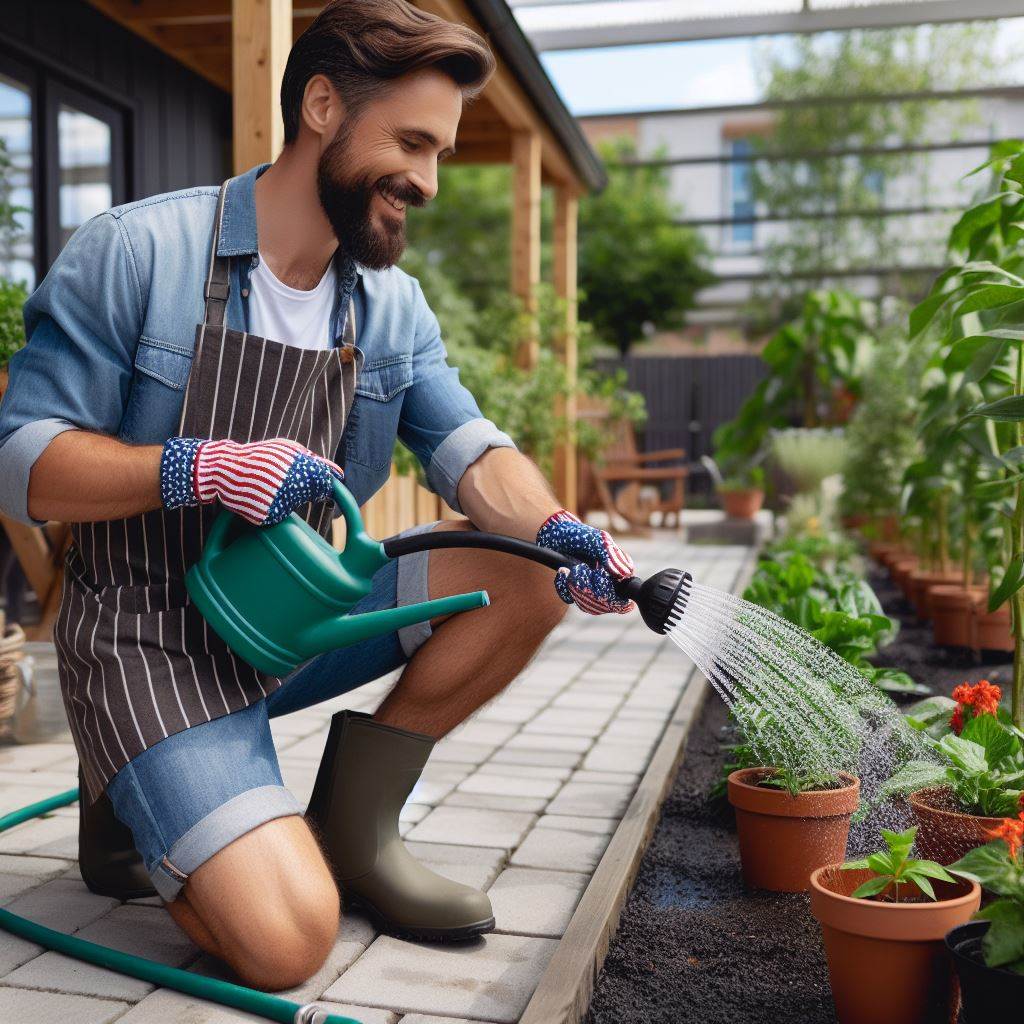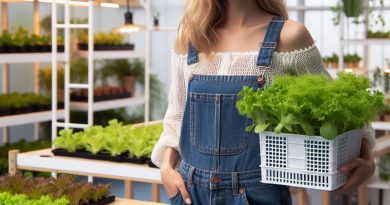Patio Farming: Fresh Food, Small Area
Last Updated on February 2, 2024
Introduction
For urban dwellers with limited outdoor space, patio farming offers a solution to grow fresh produce at home.
Also known as container gardening, patio farming utilizes pots, planters, and other vessels to cultivate edibles in small footprints.
This accessible gardening method brings numerous benefits.
Patio farming increases access to nutrient-dense, chemical-free vegetables and herbs without requiring a spacious backyard.
It promotes self-sufficiency, saves money, and reconnects city residents with nature.
With some containers, soil, seeds, vertical supports, and sunshine, patio farmers can create abundant mini farms steps from their kitchens.
In today’s world, growing our own food sustainably has become increasingly important.
Patio farming allows urbanites to participate in agriculture and enjoy the freshest ingredients.
When produce travels shorter distances, nutrients are preserved.
Patio farmers also know exactly how their food is grown.
In this series, we will explore patio gardening techniques, crop choices, and design ideas to inspire your own patio farm.
Read on to learn how you can maximize a small outdoor area to grow healthy, homegrown food.
What is Patio Farming?
Definition and concept of patio farming
Patio farming refers to the practice of growing plants in small spaces, typically on a patio or balcony.
It is a form of urban gardening that allows individuals to cultivate fresh food in a limited area.
Unlike traditional forms of farming, which require vast land and extensive resources, patio farming utilizes vertical spaces effectively.
By using containers, pots, and hanging baskets, individuals can optimize their outdoor areas to maximize food production.
Patio farming is a solution for urban dwellers who lack access to farmland or have limited outdoor space.
It brings the farm to the city, allowing people to grow their own food and enjoy the benefits of fresh, homegrown produce.
Types of plants suitable for patio farming, including herbs, vegetables, and fruits
One of the appealing aspects of patio farming is its versatility in growing various types of plants.
From herbs to vegetables and even fruits, several plant varieties thrive in containers and small spaces.
- Herbs: Herbs like basil, mint, rosemary, and thyme are ideal for patio farming. They require minimal space, can be grown in pots, and add flavor to cooking.
- Vegetables: Many vegetables can be successfully cultivated in containers, including tomatoes, peppers, lettuce, spinach, and carrots. These compact plants offer a bountiful harvest without the need for large garden plots.
- Fruits: Surprisingly, certain fruit varieties can be grown on patios. Strawberries, blueberries, and dwarf fruit trees, such as citrus or apple, can flourish in pots.
Advantages of patio farming, such as accessibility, convenience, and reduced costs
Patio farming offers several advantages that make it an attractive option for individuals seeking accessible and cost-effective ways to grow their own food.
- Accessibility: With patio farming, fresh food is just steps away. It allows individuals to have immediate access to fruits, vegetables, and herbs, eliminating the need for store-bought produce.
- Convenience: Patio farming eliminates the hassle of traveling to grocery stores or farmer’s markets. It provides the convenience of harvesting crops from the comfort of one’s home.
- Reduced Costs: By growing food at home, patio farmers can significantly reduce their grocery bills. The initial investment in containers and soil is easily offset by the savings achieved through homegrown produce.
Additionally, patio farming promotes sustainability by reducing the carbon footprint associated with transporting and packaging store-bought produce.
It also allows individuals to have control over the use of pesticides, ensuring the cultivation of healthy and organic food.
Generally, patio farming is an innovative approach to urban gardening that enables individuals to grow fresh food in small spaces.
With a wide range of plants suitable for patio farming, accessibility, convenience, and reduced costs, this practice offers an excellent solution for those seeking a sustainable and rewarding way to enjoy homegrown produce.
Read: Vertical Gardens: Maximize Your Space
Getting Started with Patio Farming
Choosing the right location for your patio farm
- Identify an area on your patio that receives ample sunlight throughout the day.
- Ensure the location is sheltered from strong winds and extreme temperatures.
- Consider the proximity to a water source for easy watering of your plants.
Assessing available space and sunlight exposure
- Measure the available space on your patio to determine the size and number of containers you can accommodate.
- Observe the sunlight patterns in different areas of your patio to place plants accordingly.
- Take note of any shady spots and avoid placing light-loving plants in these areas.
Selecting appropriate containers and pots for different plants
- Choose containers with drainage holes to prevent waterlogging and promote healthy root growth.
- Opt for larger pots for plants that require more root space and smaller pots for compact varieties.
- Consider the material of the containers based on durability, aesthetics, and insulation properties.
Understanding soil and fertilizer requirements for patio farming
- Use high-quality potting soil or a blend of compost, peat moss, and perlite for container gardening.
- Ensure the soil is well-draining and provides adequate nutrients for plant growth.
- Consider using slow-release organic fertilizers or liquid fertilizers according to the specific needs of your plants.
Incorporating vertical gardening techniques to maximize space
- Utilize trellises, stakes, or wall-mounted planters to grow vining plants vertically.
- Hang baskets or tiered planters to create height and maximize the use of space.
- Train plants to grow against a wall or fence using espalier techniques to save space horizontally.
Patio farming offers the opportunity to grow fresh food even in small areas.
By following these steps, you can get started on your own patio farm and enjoy the satisfaction of harvesting homegrown produce.
Read: Compact Composting: Urban Eco Tips
Selecting Plants for Your Patio Farm
Popular herbs and their growth requirements
- Basil: Needs full sun, well-drained soil, and regular watering. Container size: 8-12 inches.
- Mint: Thrives in partially shaded areas and moist soil. Container size: 12-16 inches.
- Rosemary: Requires full sun and well-drained soil. Container size: 14-16 inches.
- Thyme: Prefers full sun and well-drained soil. Container size: 8-12 inches.
- Parsley: Grows best in partial shade and moist soil. Container size: 10-12 inches.
Best vegetables for patio farming and their container size and spacing needs
- Tomatoes: Choose compact varieties like cherry or patio tomatoes. Container size: 14-20 inches. Spacing: 24-36 inches.
- Peppers: Ideal for containers and require well-drained soil. Container size: 12-16 inches. Spacing: 18-24 inches.
- Lettuce: Fast-growing and suitable for smaller containers. Container size: 6-10 inches. Spacing: 6-8 inches.
- Beans: Bush varieties work well in containers. Container size: 12-16 inches. Spacing: 4-6 inches.
- Radishes: Quick-growing and perfect for smaller containers. Container size: 4-6 inches. Spacing: 1-2 inches.
Dwarf fruit tree varieties suitable for patio farming
- Lemon Tree: Choose dwarf lemon tree varieties that can be grown in containers. Container size: 18-24 inches.
- Apple Tree: Look for dwarf apple tree varieties suitable for patio farming. Container size: 24-36 inches.
- Fig Tree: Dwarf fig tree varieties are well-suited for growing on patios. Container size: 18-24 inches.
Considerations for growing plants in different seasons
- Spring: Plant cool-season crops like lettuce, spinach, and peas. Protect from late frosts.
- Summer: Grow heat-tolerant vegetables such as tomatoes, peppers, and cucumbers. Provide shade and adequate watering.
- Fall: Plant cool-season crops again, like carrots, beets, and kale. Protect from early frosts.
- Winter: Consider growing cold-hardy vegetables like Brussels sprouts, cabbage, and winter greens with proper insulation.
By selecting the right plants for your patio farm, you can enjoy a variety of fresh herbs, vegetables, and even fruits throughout the year.
Keep in mind their growth requirements, container sizes, spacing needs, and the season in which they thrive.
With proper care and attention, your patio farm can be a flourishing source of fresh and nutritious produce.
Start small and experiment with different plants to find the ones that suit your taste and patio conditions the best.
Happy patio farming!
Read: Rooftop Gardens: Sky-High Greenery

Caring for Your Patio Garden
Watering techniques and soil moisture management
- Water your patio plants thoroughly, ensuring that the soil is evenly moist.
- Use a watering can or hose with a nozzle attachment to control the water flow.
- Avoid overwatering by checking the soil moisture level with your finger before watering.
- Install a drip irrigation system to provide a consistent water supply to your patio plants.
- Mulch the soil surface with organic materials to retain moisture and reduce evaporation.
- Group your plants based on their water needs to avoid under or overwatering specific plants.
- Consider using self-watering containers or reservoir planters for efficient water management.
Controlling pests and diseases in a limited space
- Monitor your patio plants regularly for signs of pests or diseases like wilting or discoloration.
- Remove any infected or infested plant parts immediately to prevent the spread of pests or diseases.
- Encourage beneficial insects like ladybugs or lacewings to control pests naturally.
- Introduce organic pest control methods such as neem oil or insecticidal soaps when necessary.
- Companion planting with pest-repellent plants like marigolds or basil can deter pests.
- Keep your patio garden clean and free of debris that can harbor pests or diseases.
- Follow proper hygiene practices, such as disinfecting tools and pots, to prevent disease transmission.
Pruning and trimming methods for patio plants
- Prune your patio plants regularly to maintain their shape, promote healthy growth, and control size.
- Use sharp and clean pruners to make clean cuts and reduce the risk of disease transmission.
- Remove dead or damaged foliage to improve overall plant appearance and prevent disease.
- Trim back any overgrown branches or vines that may shade or overcrowd other plants.
- Pinch back the tips of plants to promote bushier growth and enhance flower production.
- Train climbing or vining plants along trellises or supports to maximize vertical space.
- Research specific pruning techniques for different types of patio plants to ensure proper care.
Regular fertilization and soil amendment practices
- Feed your patio plants with a balanced and slow-release fertilizer every 4-6 weeks during the growing season.
- Apply organic fertilizers, such as compost or well-rotted manure, to enrich the soil.
- Avoid over-fertilization, which can lead to nutrient imbalances and damage to the plants.
- Test your soil regularly to monitor nutrient levels and adjust your fertilization practices accordingly.
- Incorporate organic matter, like compost or peat moss, into the soil to improve its structure and fertility.
- Use mulch to add nutrients to the soil over time and reduce weed growth.
- Follow the specific fertilization recommendations for each type of plant to ensure optimal growth.
Taking care of your patio garden requires attention to watering techniques, pest control, pruning, and fertilization.
By implementing these practices, you can enjoy a thriving and productive small-space garden.
So get your gardening gloves on and start tending to your patio plants!
Read: Urban Farming: Small Plot, Big Yield
Harvesting and Enjoying the Fruits of Your Patio Farm
Indicators of plant maturity and readiness for harvest
- Pay attention to the growth and development of your patio farm plants.
- Look for signs such as color changes, firmness, and size to determine maturity.
- Check if fruits or vegetables are easily plucked from the plant without resistance.
- Properly ripe produce will have a sweet aroma and vibrant color.
Proper harvesting techniques to promote plant health and future growth
- Use clean and sharp tools, such as gardening shears or scissors, to avoid damaging the plant.
- Harvest during the cooler parts of the day to prevent stress on the plants.
- Gently remove produce from the plant, ensuring no unnecessary force is applied.
- Cut stems at a slant, leaving a small portion intact to avoid injuring the plant.
- Avoid leaving any decaying or damaged produce on the plant, as it can attract pests.
Delicious recipes using freshly harvested patio farm produce
- Caprese Salad: Combine freshly harvested tomatoes, basil leaves, and mozzarella. Drizzle with olive oil and balsamic vinegar.
- Stir-Fried Vegetables: Sauté freshly harvested peppers, carrots, and snap peas with garlic and soy sauce.
- Grilled Zucchini: Slice freshly harvested zucchini, brush with olive oil, and grill until tender. Season with salt and pepper.
- Garden Fresh Salsa: Dice freshly harvested tomatoes, onions, jalapenos, and cilantro. Mix with lime juice and salt for a refreshing dip.
- Basil Pesto: Blend freshly harvested basil leaves, pine nuts, garlic, parmesan cheese, and olive oil. Serve with pasta or as a spread.
Sharing extra produce with friends and neighbors
- Spread the joy of patio farming by sharing your abundance of harvested produce.
- Offer a basket or bag of fresh fruits and vegetables to neighbors and friends.
- Use excess produce to create homemade gifts, such as preserves or pickles.
- Organize a community exchange where individuals can trade their surplus produce.
- Donate extra produce to local food banks or shelters to help those in need.
Troubleshooting Common Challenges in Patio Farming
Dealing with limited sunlight or excessive shade
- Choose plants that are tolerant of low sunlight conditions, such as leafy greens like spinach and lettuce.
- Consider moving your patio plants to sunnier spots during the day or using reflective surfaces to redirect sunlight.
- Prune surrounding trees or bushes to allow more sunlight to reach your patio plants.
- Supplement natural sunlight with artificial lighting, using grow lights if necessary.
Overcoming space constraints and maximizing productivity
- Opt for compact plant varieties or dwarf cultivars that require less space but still yield a good harvest.
- Utilize vertical space by installing trellises, hanging baskets, or wall-mounted planters.
- Practice succession planting, which involves planting new crops as soon as the previous ones are harvested.
- Interplant compatible crops to make the most of your limited space and maximize yields.
Identifying and addressing nutrient deficiencies in patio plants
- Regularly inspect your plants for signs of nutrient deficiencies, such as yellowing leaves or stunted growth.
- Conduct a soil test to determine nutrient levels and adjust fertilizer applications accordingly.
- Use organic fertilizers or compost to enrich the soil and provide a balanced nutrient supply.
- Practice crop rotation to prevent nutrient depletion and maintain soil fertility.
Preventing and managing common pests and diseases
- Monitor your plants regularly for signs of pests or diseases, such as wilting leaves or insect damage.
- Implement preventive measures, such as providing proper spacing between plants and good airflow to discourage pests.
- Use organic pest control methods, like introducing beneficial insects or applying neem oil or insecticidal soap.
- If a plant is already infected, promptly remove and dispose of it to prevent the spread of diseases.
By properly addressing these common challenges, you can ensure the success of your patio farming endeavors.
Remember to adapt your strategies based on the specific conditions and limitations of your space.
Patio farming may have its challenges, but with creativity and resourcefulness, you can enjoy fresh, homegrown produce even in a small area.
Conclusion
We’ve explored the many benefits of growing food right on your patio.
This urban farming method maximizes small outdoor areas to provide fresh produce.
Patio farming increases access to nutrient-rich vegetables and herbs without needing a large garden plot.
It also promotes self-sufficiency, saves money at the grocery store, and reconnects urban dwellers with nature.
For those with limited space, patio farming is the perfect solution.
Now it’s your turn to give patio gardening a try!
Start with compact vegetables like lettuce, tomatoes, peppers, or bush beans.
Use vertical space by trellising climbing plants on walls and fences.
Add interest with edible flowers and colorful containers.
Patio farming is low commitment, so jump in and enjoy the fruits of your labor!
No outdoor area is too small to grow something tasty.
Share your experiences in the comments!
We’d love to hear about your favorite patio crops, unique containers, space-saving tips, and harvest photos.
Together we can turn urban patios into abundant mini farms.
So grab some pots, seeds, and get planting – your fresh food oasis awaits!


